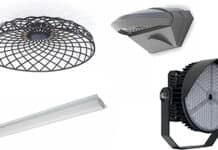Amerlux, a design-and-manufacture lighting company, announced the launch of a hi-tech, electrical receptacle for its Avista light engine that will turn humble light posts into the bold underpinnings of a smart city.
Amerlux’s 7-pin option, used in conjunction with its Avista pedestrian light engine, can transform any lamp post into a wireless communication device that can connect to larger municipal networks. Reminiscent of when phones became “smarter” with apps, Amerlux is designing products that leverage existing circuit boards in LEDs to become compatible with a variety of sensors that drastically change the utility of lighting.
“Our lighting solutions can collect data to allow city managers to make better, real-time decisions, delivering safer streets, cleaner neighborhoods, and smarter cities,” said Amerlux CEO and President Chuck Campagna. “The 7-pin option underscores Amerlux’s tradition of innovation, which stems from listening to the marketplace.”
The Avista light engine is available in three options: standard without an electrical socket, 3-pin with a NEMA twist-lock electrical receptacle, and the 7-pin with a NEMA socket and “extra” pins that add dimming capabilities and access to a world of cutting-edge sensors.
With Amerlux’s 7-pin option, for example, city managers would have more capabilities, including:
- Surveil criminal activity, including gunshot detection
- Monitor trash removal and street cleaning
- Count traffic to determine outcomes of project modifications
- Track air quality to protect residents
- Install Wi-Fi access points to improve communications
- Adjust lighting remotely to ensure output matches need
The manufacturer’s new guide—“Making Smart Cities Brilliant: How Amerlux Provides Beacon of Light for Tomorrow”—provides details about how cities are using similar technology, as well as new mega-cities that are ready to break ground.
 In effect, streetlights can become the perfect foundation for smart cities because they provide the power and the pole, which create a physical platform for the sensors. With a small forward-thinking investment added onto a lighting upgrade, cities can lay the ground work for their future by purchasing lights with the 7-pin option.
In effect, streetlights can become the perfect foundation for smart cities because they provide the power and the pole, which create a physical platform for the sensors. With a small forward-thinking investment added onto a lighting upgrade, cities can lay the ground work for their future by purchasing lights with the 7-pin option.
Since LEDS last for 50,000-100,000 hours (10-20 years), municipalities can maximize future options with the 7-pin receptacle, even if a city isn’t ready for the full investment toward creating a smart city; the city can use today’s wireless controls and the controls of tomorrow, which are still being developed.
The Avista light engine was recently was granted a U.S. patent protection for intellectual property incorporated into the product. Its IP66 sealed LED optical chamber prevents water intrusion, which is the main cause of light failure. In addition, Avista was designed for new construction applications and retrofits, which take less than 15 minutes per unit to install.
To date, the City of Los Angeles has upgraded more than 600 decorative streetlights with Avista LED light engines, realizing up to 75 percent reduction in lighting energy consumption and costs. (Read the complete case study.)
The City of Portland in Oregon upgraded its acorn fixtures going from 100-watt HPS to 42-watt LEDs, saving about 60 percent in energy consumption and costs. (Read the complete case study.)

















![[VIDEO] Collect Asset Data at the Speed of Walking a Building](https://facilityexecutive.com/wp-content/uploads/2024/02/maxresdefault-324x160.jpg)